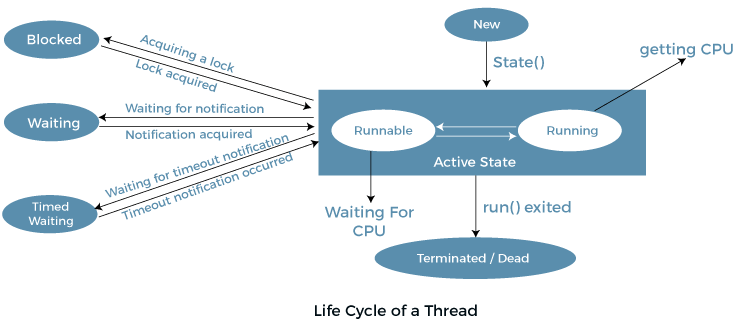Life cycle of a Thread (Thread States)In Java, a thread always exists in any one of the following states. These states are:
Explanation of Different Thread StatesNew: Whenever a new thread is created, it is always in the new state. For a thread in the new state, the code has not been run yet and thus has not begun its execution. Active: When a thread invokes the start() method, it moves from the new state to the active state. The active state contains two states within it: one is runnable, and the other is running.
Blocked or Waiting: Whenever a thread is inactive for a span of time (not permanently) then, either the thread is in the blocked state or is in the waiting state. For example, a thread (let's say its name is A) may want to print some data from the printer. However, at the same time, the other thread (let's say its name is B) is using the printer to print some data. Therefore, thread A has to wait for thread B to use the printer. Thus, thread A is in the blocked state. A thread in the blocked state is unable to perform any execution and thus never consume any cycle of the Central Processing Unit (CPU). Hence, we can say that thread A remains idle until the thread scheduler reactivates thread A, which is in the waiting or blocked state. When the main thread invokes the join() method then, it is said that the main thread is in the waiting state. The main thread then waits for the child threads to complete their tasks. When the child threads complete their job, a notification is sent to the main thread, which again moves the thread from waiting to the active state. If there are a lot of threads in the waiting or blocked state, then it is the duty of the thread scheduler to determine which thread to choose and which one to reject, and the chosen thread is then given the opportunity to run. Timed Waiting: Sometimes, waiting for leads to starvation. For example, a thread (its name is A) has entered the critical section of a code and is not willing to leave that critical section. In such a scenario, another thread (its name is B) has to wait forever, which leads to starvation. To avoid such scenario, a timed waiting state is given to thread B. Thus, thread lies in the waiting state for a specific span of time, and not forever. A real example of timed waiting is when we invoke the sleep() method on a specific thread. The sleep() method puts the thread in the timed wait state. After the time runs out, the thread wakes up and start its execution from when it has left earlier. Terminated: A thread reaches the termination state because of the following reasons:
A terminated thread means the thread is no more in the system. In other words, the thread is dead, and there is no way one can respawn (active after kill) the dead thread. The following diagram shows the different states involved in the life cycle of a thread. 
Implementation of Thread StatesIn Java, one can get the current state of a thread using the Thread.getState() method. The java.lang.Thread.State class of Java provides the constants ENUM to represent the state of a thread. These constants are: It represents the first state of a thread that is the NEW state. It represents the runnable state.It means a thread is waiting in the queue to run. It represents the blocked state. In this state, the thread is waiting to acquire a lock. It represents the waiting state. A thread will go to this state when it invokes the Object.wait() method, or Thread.join() method with no timeout. A thread in the waiting state is waiting for another thread to complete its task. It represents the timed waiting state. The main difference between waiting and timed waiting is the time constraint. Waiting has no time constraint, whereas timed waiting has the time constraint. A thread invoking the following method reaches the timed waiting state.
It represents the final state of a thread that is terminated or dead. A terminated thread means it has completed its execution. Java Program for Demonstrating Thread StatesThe following Java program shows some of the states of a thread defined above. FileName: ThreadState.java Output: The state of thread t1 after spawning it - NEW The state of thread t1 after invoking the method start() on it - RUNNABLE The state of thread t2 after spawning it - NEW the state of thread t2 after calling the method start() on it - RUNNABLE The state of thread t1 while it invoked the method join() on thread t2 -TIMED_WAITING The state of thread t2 after invoking the method sleep() on it - TIMED_WAITING The state of thread t2 when it has completed it's execution - TERMINATED Explanation: Whenever we spawn a new thread, that thread attains the new state. When the method start() is invoked on a thread, the thread scheduler moves that thread to the runnable state. Whenever the join() method is invoked on any thread instance, the current thread executing that statement has to wait for this thread to finish its execution, i.e., move that thread to the terminated state. Therefore, before the final print statement is printed on the console, the program invokes the method join() on thread t2, making the thread t1 wait while the thread t2 finishes its execution and thus, the thread t2 get to the terminated or dead state. Thread t1 goes to the waiting state because it is waiting for thread t2 to finish it's execution as it has invoked the method join() on thread t2.
Next TopicHow to create thread
|
 For Videos Join Our Youtube Channel: Join Now
For Videos Join Our Youtube Channel: Join Now
Feedback
- Send your Feedback to [email protected]
Help Others, Please Share










